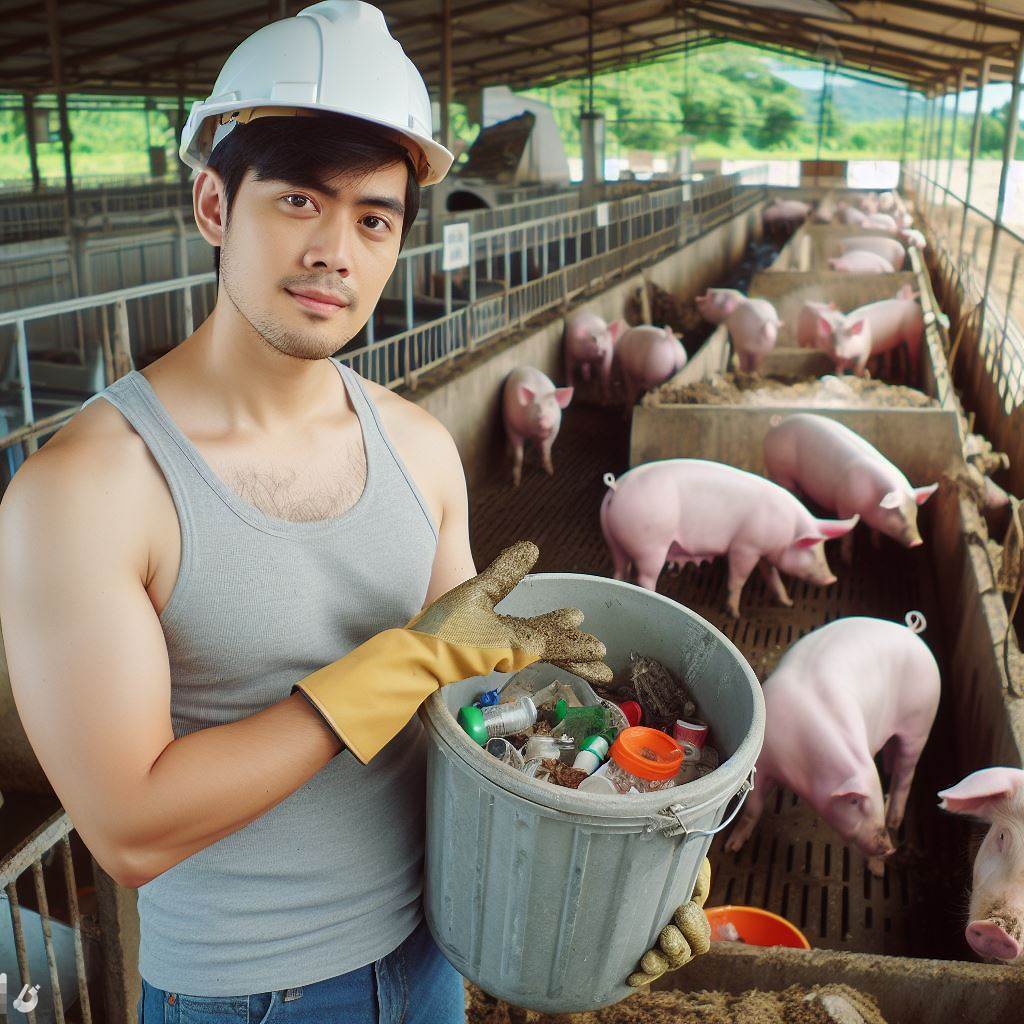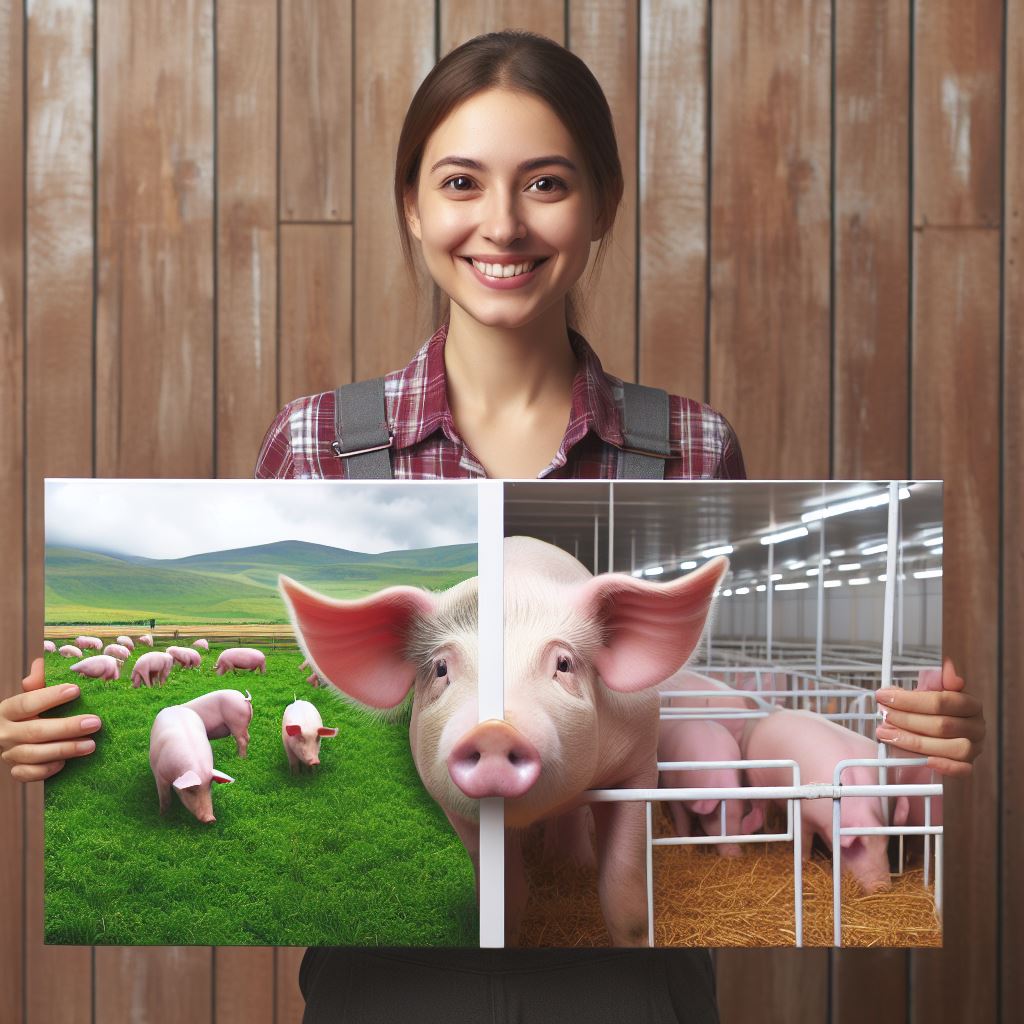Introduction
Understanding Pig Behavior
- Pigs are social animals with distinct behaviors.
- They communicate through vocalizations, body language, and interactions.
- Behaviors include rooting, nesting, and group dynamics.
Importance for Farmers
- Efficient Farm Management: Understanding behavior aids in better herd management.
- Health Monitoring: Detecting abnormal behaviors helps identify potential health issues early.
- Stress Reduction: Knowledge of pig behavior enables farmers to create stress-free environments.
- Improved Productivity: Tailoring conditions to natural behaviors enhances overall pig well-being and productivity.
In this post, we delve into the intricacies of pig behavior, highlighting its significance for farmers striving for optimal herd management and pig welfare.
Basic Pig Behavior
Social structure within a pig herd
- Pigs live in hierarchical groups, with each herd having a distinct social order.
- The dominant pigs, known as the leaders, establish their authority through physical displays.
- Lower-ranking pigs submit to the leaders’ dominance and follow their cues in various activities.
- Social structure helps maintain order, prevents conflicts, and ensures cooperation within the herd.
Communication methods among pigs
- Vocalizations play a crucial role in pig communication, expressing various emotions and needs.
- Pigs use different types of grunts, snorts, squeals, and screams to convey their intentions and emotions.
- Each vocalization has a distinct meaning, such as seeking attention, expressing fear or dominance, or calling for companionship.
- Effective communication ensures coordination within the herd and helps build harmonious relationships.
- Body language and gestures are equally important in pig communication, allowing them to understand each other’s intentions.
- Ear position, tail movements, and physical postures communicate emotions, submission, aggression, or playfulness.
Daily routines and activities of pigs
- Pigs have well-established daily routines that revolve around feeding, sleeping, and socializing.
- Feeding habits vary among pigs, but most commonly, they forage for food using their snouts.
- Pigs may also engage in rooting activities, searching for roots, tubers, or insects.
- They are highly adaptable and can adjust their feeding habits to the available resources.
- When it comes to sleeping, pigs prefer to have a designated area where they can rest comfortably.
- They often form piles, known as “pig piles,” to conserve body heat and establish a sense of security.
- Pigs are naturally playful and curious animals, showing interest in exploring their surroundings.
- Play behaviors, such as running, chasing, and wrestling, are common among piglets and young pigs.
- Exploration helps pigs learn about their environment and develop essential skills for survival.
Understanding the basic behavior of pigs is crucial for pig farmers, caretakers, and anyone interested in these intelligent creatures.
By grasping their social structure, communication methods, and daily routines, we can provide better care, ensure their welfare, and establish a strong bond with our pig herds.
Read: Cost-Efficient Pig Farming Tips
Understanding Pig Senses
Pig behavior is closely tied to their sensory abilities, which play a significant role in their daily lives.
Understanding how pigs perceive the world through their senses can help in managing and providing appropriate care for your herd.
Sensory Abilities of Pigs
- Vision: Pigs have relatively good vision and can perceive both color and depth. They have a wide field of view, which allows them to see objects on either side without turning their heads.
- Hearing: Pigs have an acute sense of hearing and can detect sounds at frequencies beyond human capabilities. They are particularly sensitive to high-pitched sounds and can easily discern changes in tone.
- Smell: Pigs possess an exceptional sense of smell, surpassing even that of dogs. Their well-developed olfactory system enables them to detect odors in the environment, including food sources and potential dangers.
- Taste: Pigs have taste buds capable of recognizing basic tastes such as sweet, salt, sour, and bitter. They use their sense of taste to determine the palatability of their food and make dietary choices.
- Touch: Pigs have a highly sensitive sense of touch, especially with their snouts, which are rich in nerve endings. They explore their surroundings by rooting, nudging, and using tactile sensations.
How These Senses Influence Pig Behavior
- Reacting to visual stimuli: Pigs respond to visual cues in their environment, such as sudden movements or objects. They may exhibit startled or defensive behaviors when they perceive a potential threat.
- Importance of sound in communication: Pigs use different vocalizations to express a range of emotions and messages. They rely on hearing to interpret these sounds and also to recognize the presence of other pigs.
- Pheromones and scent marking: Pigs release pheromones through glands in their bodies, which serve as chemical signals used for communication. They also mark their territories and establish social hierarchies through olfactory cues.
- Food preferences and foraging behavior: Pigs have a keen sense of smell and use it to detect and locate food. Their preferences for certain food items influence their foraging behavior and dietary choices.
- Reactions to touch and physical contact: Pigs enjoy physical contact, especially with other pigs or humans they are familiar with. They may seek out opportunities for social interaction and show signs of pleasure or relaxation when being touched.
Understanding and appreciating pig senses is integral to promoting their well-being and managing their behavior.
Providing a stimulating and enriched environment that engages their senses can help to alleviate boredom and reduce stress within the herd.
Read: Innovations in Swine Welfare

Factors Affecting Pig Behavior
Environmental factors
Environmental factors have a profound effect on pig behavior.
The temperature and weather conditions pigs are subjected to play a crucial role in their overall behavior and well-being.
Pigs are highly sensitive to extreme temperatures, and their behavior can be influenced by heat stress or cold stress.
It is essential to provide appropriate temperature control measures to ensure pig comfort and prevent negative impacts on health and performance.
Additionally, weather conditions such as excessive rain, wind, or storms can cause pigs to exhibit anxious or agitated behavior.
This can lead to increased stress levels and potentially affect their growth and productivity.
Transform Your Agribusiness
Unlock your farm's potential with expert advice tailored to your needs. Get actionable steps that drive real results.
Get StartedThe space and housing requirements for pigs also significantly affect their behavior.
Overcrowded or poorly ventilated spaces can lead to aggression, restlessness, or abnormal behaviors.
Pigs need enough space to move freely, socialize, and engage in natural behaviors, so adequate space allowances should be ensured.
Proper housing design and maintenance are crucial for promoting positive pig behavior.
Comfortable and clean bedding, access to fresh air, and appropriate flooring material help create an ideal living environment for pigs, reducing stress and promoting overall well-being.
Lighting conditions are another important environmental factor that influences pig behavior.
Pigs have a natural circadian rhythm, and light affects their biological functions, such as sleep, appetite, and reproduction.
Providing a consistent light-dark cycle helps regulate pig behavior and ensures proper growth and development.
It is important to maintain appropriate lighting conditions to support pigs’ natural behaviors and prevent disturbances in their daily routines.
Management practices and handling techniques
Management practices and handling techniques greatly impact pig behavior.
Human interaction with pigs can have both positive and negative effects on their behavior and well-being.
Pigs raised in environments where they receive positive human interaction tend to be more docile, sociable, and easier to handle.
On the other hand, negative or rough handling can cause fear, stress, and aggression in pigs, leading to behavioral issues and reduced welfare.
Proper training of personnel in handling techniques is essential to ensure pigs are treated gently and responsibly, minimizing stress and promoting positive behavior.
The role of routine and consistency in managing pigs is also crucial.
Pigs thrive on routine, and any sudden changes in their feeding, handling, or environmental conditions can cause stress and disrupt their behavior.
Establishing a consistent routine helps pigs feel secure and reduces anxiety.
Consistency in management practices, such as feeding schedules, cleaning routines, and handling methods, promotes a stable and predictable environment for pigs, leading to more settled behavior and improved overall welfare.
Health and welfare considerations
Pigs’ health status and overall welfare significantly affect their behavior.
Illness or injury can have a direct impact on pig behavior, causing changes in their social interactions and feeding habits.
Sick or injured pigs may exhibit signs of lethargy, decreased appetite, increased irritability, or isolation from the group.
It is important to regularly monitor pigs’ health and promptly address any signs of illness or injury to prevent further negative impacts on behavior and overall well-being.
Observing behavioral indicators is essential for assessing pig well-being.
Pigs should engage in normal behaviors, such as socializing, exploring their surroundings, and playing.
Showcase Your Farming Business
Publish your professional farming services profile on our blog for a one-time fee of $200 and reach a dedicated audience of farmers and agribusiness owners.
Publish Your ProfileAbnormal behaviors, such as constant aggression, excessive fear, abnormal posture, or repetitive movements, may indicate potential welfare issues.
Regular behavioral assessments help identify any deviations from normal pig behavior and allow for appropriate intervention to maintain their welfare.
Therefore, several factors influence pig behavior.
Environmental factors, such as temperature, weather, space, and lighting conditions, greatly impact pig well-being.
Good management practices, including positive human interaction, routines, and consistency, contribute to favorable pig behavior.
Health and welfare considerations play a vital role in maintaining positive behavior in pigs.
By understanding and addressing these factors, pig farmers can promote optimal behavior and overall well-being in their herds.
Read: Organic Feed for Healthy Pigs
You Might Also Like: Pig Farming Essentials: A Beginner’s Guide
Handling and Training Techniques
Importance of proper pig handling for both humans and pigs
Proper pig handling is essential to ensure the welfare of both humans and pigs.
When pigs are handled correctly, stress and injuries can be minimized, creating a safer and more productive environment.
Pigs, like all animals, have specific behavioral characteristics that need to be considered when handling them.
Understanding their natural behaviors, instincts, and reactions can help improve the overall handling experience and reduce negative outcomes.
Techniques for reducing stress and improving pig behavior
Positive reinforcement training
Positive reinforcement training involves rewarding desired behaviors to encourage their repetition.
This technique is effective in teaching pigs to respond to commands, reducing stress and improving behavior.
By offering treats or praise when pigs exhibit desired behavior, they learn to associate those actions with positive outcomes.
Efficient and safe herding methods
When herding pigs, it is important to use techniques that minimize stress and prevent aggression or injuries.
Gentle, steady pressure should be applied from behind to encourage forward movement.
Avoid loud noises or sudden movements that could startle or agitate the pigs. Patience and calmness are key to successful herding.
Using appropriate equipment and facilities
Having the right equipment and facilities is crucial for safe and efficient pig handling.
Sturdy and well-designed chutes, gates, and handling areas are essential to prevent injuries and facilitate the movement of pigs.
Non-slip surfaces and proper lighting also contribute to a less stressful environment.
Regular maintenance and inspections are necessary to ensure everything is in good working condition.
To further minimize stress, it is essential to avoid overcrowding pigs and allow them sufficient space to move comfortably.
Adequate space reduces competition and aggression, promoting better behavior and overall well-being.
In addition to these techniques, it is important to maintain a calm and confident demeanor when handling pigs.
Pigs can sense fear or anxiety, which can escalate their stress levels and lead to unpredictable behavior.
Establishing trust and a positive relationship through consistent and respectful handling can greatly improve pig behavior and handling outcomes.
Most importantly, proper pig handling techniques are crucial for both humans and pigs.
By understanding pig behavior and using approaches such as positive reinforcement training, efficient herding methods, and appropriate equipment and facilities, pig stress can be reduced, and behavior can be improved.
This not only promotes the welfare and well-being of the pigs but also creates a safer and more productive environment for those handling them.
Read: Sustainable Pig Farming Techniques
Conclusion
Recap of key points discussed in the blog post:
- Pig behavior is complex and influenced by various factors such as genetics, environment, and social dynamics.
- Understanding pig behavior is crucial for successful herd management and animal welfare.
- Observation and documentation are important tools for gaining insights into pig behavior.
- Common pig behaviors include rooting, wallowing, social hierarchy, and maternal instincts.
Encouragement for farmers to deepen their understanding of pig behavior
Farmers should invest time and resources into studying pig behavior as it can lead to more efficient and sustainable farming practices.
By understanding pig behavior, farmers can anticipate and prevent issues such as aggression, stress, and disease.
Deepening their knowledge of pig behavior can also lead to improved breeding programs, feeding strategies, and overall herd management.
Importance of utilizing this knowledge to improve animal welfare and farm management practices
Understanding pig behavior allows farmers to create environments that meet the physical and psychological needs of their pigs.
By providing appropriate housing, feeding, and socializing opportunities, farmers can ensure the well-being of their pigs.
Using this knowledge can also lead to more efficient resource utilization, reduced environmental impact, and improved profitability.




